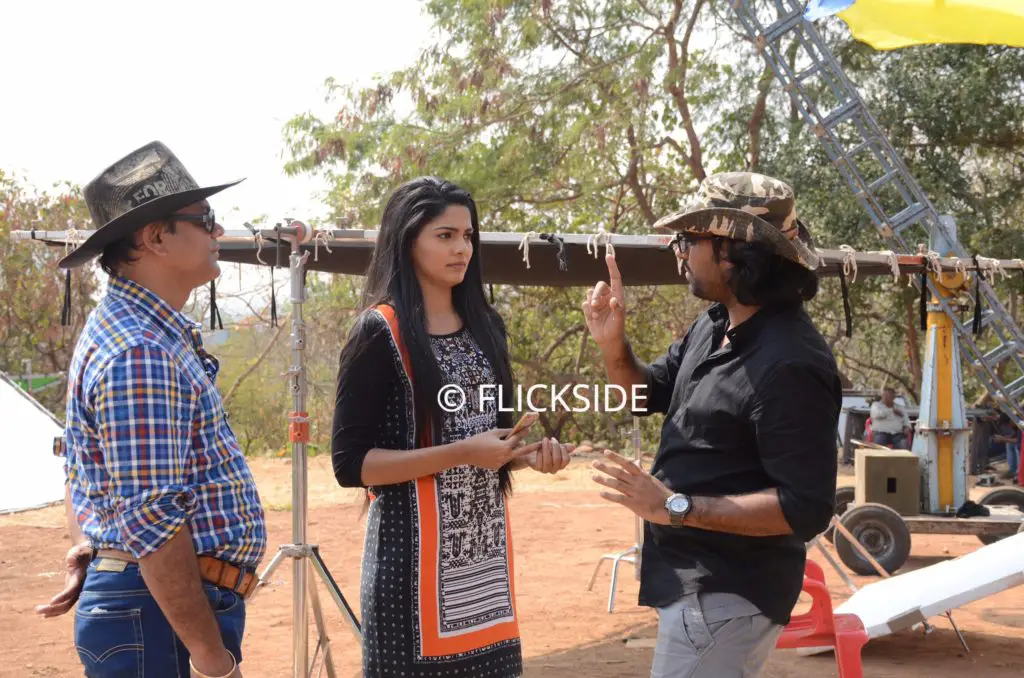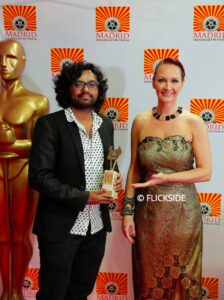“My three Ps: passion, patience, perseverance. You have to do this if you’ve got to be a filmmaker.” – Robert Wise
Mainstream Indian cinema has largely failed to tap the horror genre. Absurd themes, shoddy visuals, unintentionally comical effects – we’ve been dished out all. Lately though, indie filmmakers have been curiously experimental, redefining and rewriting the rules of the genre. So, when a regional filmmaker’s efforts in this genre find resonance and recognition at a global stage, it’s a proud moment.
After decade-long experience in television, Vishal Furia directed his first feature film Lapachhapi (Marathi) this year. It became the first Indian horror film to get officially selected for the Brooklyn International Film Festival and has already won several awards and nominations at other global fests. But today, Vishal talks to Flickside about what went into making his debut feature — cast, crew, funding, challenges and shares some valuable lessons for first-time filmmakers.
Recommended: 6 Indie Directors Reveal Films That Inspired Them
Those of you planning to make your first film, listen in close.
What inspired Lapachhapi?
In India, we do not make good horror movies. The negligence and abuse of the horror genre has always irritated and frustrated me, being a horror film fan myself. So, I wanted to do something in this genre which was original and Indian. Something that wasn’t copied from the western horror movies. While dabbling with ideas in this genre, one that came to my mind was Lapachhapi, which is born from Indian facts and stories. And once I was convinced with the idea and the originating story, I thought it would be the perfect debut.
How difficult was getting it off the starting block? How did the funding come about?
In India, horror is an abused genre corrupted by sex, songs and masala. That’s the primary reason our horror films haven’t seen as much success as those in the west. So, Indian producers are least enthusiastic to explore this genre. Which made it extremely difficult to find funding for the film. Also, the question that most debutant directors face is ‘How can we trust you when you have never ever made a film before?’ which is a funny question in itself. All these things added to my woes. It finally took a businessman like Jitendra Patil, who is not a traditional producer, to see the power of the story and trust me and my team to finally agree on producing the film. The process to find the producer took more than a year.
Recommended: 6 Indie Director’s Have Tips For First-Time Filmmakers
How was the idea of Lapachhapi translated into a script and into a screenplay? How long did it take from when you started writing until you called it a wrap?
Ideas are just seeds which have to be nurtured and grown. For me, it is usually a visual. So, I expanded the basic idea into a few permutations and combinations and then chose the best combination to turn it into a full-fledged story. It then evolved into screenplay and dialogues with the help of Vishal Kapoor, the writer of Lapachhapi.
It took me about 2 months to write the story, about a year to find the producer, 2 months of pre-production, 2 months of wait before we went on floor, 16 days of shoot, 2 months of postproduction. So a little less than 2 years from idea to first copy.
“Indian filmmakers that influence me are Mani Ratnam, Dibakar Banerjee, Vishal Bhardwaj, Imtiaz Ali.”
How do you approach a film? How much of it is storyboard, how much of it is planning on the set?
I have been professionally trained in VFX. Going to the set unplanned is criminal for a VFX artist. Pre-production is my strongest skill set. I go to the sets after planning to the smallest detail leaving very less scope for things to change. But at the same time, I am flexible enough for positive last minute changes.

How did you go about finding the perfect cast and crew? How big was the team? What is the bare minimum crew required to get a film going?
Due to the nature of the story, the casting became difficult but it all worked out perfectly in the end. The Marathi industry has some amazing artists. I am honored to have performers like Pooja Sawant, Usha Naik madam, Vikram Gaikwad and Anil Gawas sir in my film.
I’ve worked in television for 13 years and the technical people I worked successfully with over the years became my film crew. For a debutante filmmaker, it’s very important that the team is supportive of the director’s vision. Don’t shy away from asking favors from friends who you’ve worked with over the years. Get a team which is as hungry and ambitious as you are to prove a point.
Lapachhapi (2017): Finally An Indian Horror Film That Thwarts Genre Tropes
Though every department is important, the most important are the DoP (Director of Photography) and the chief assistant or associate director. Do not compromise on these two. It’s very important that the film looks good.
In my case, my very old friend Chandan Kowli, who’s an excellent DoP, came on board. And Lapachhapi is looking rich. I guess a minimum film crew depends on the concept of the film. It can be as less as 15 to 20 people too. Gareth Edwards shot a feature film with a crew of 5 people. So there’s no rule. A hard working crew is important.
“I must have done a few hundred meetings before I met the right person. The only key to the whole process is ‘be persistent’.”
What kind of films and filmmakers have influenced or inspired you?
My inspiration in horror comes mostly from Spanish and Japanese horror films. Some of my favorite filmmakers (not particularly horror) are Guillermo Del Toro, Stanley Kubrick, Takashi Miike, Wong Kar Wai.
Indian filmmakers that influence me are Mani Ratnam, Dibakar Banerjee, Vishal Bhardwaj, Imtiaz Ali to name a few.
For an outsider, what does it take to break into the industry?
For someone like me who comes from the TV industry with absolutely no contacts in the film industry, it was extremely difficult to get meetings with people. I must have done a few hundred meetings before I met the right person. The only key to the whole process is ‘be persistent’. If a person believes in his idea strongly, he’ll definitely find someone with whom the idea will resonate.
But a person has to be extremely patient. Most lose out due to this battle with time and money. Also save enough so as to sustain yourself financially during this process. That’s very important.
“Funding will not work out, producers will back out, actors will back out, schedules will keep postponing, your team members will fight with you…”
Our failures teach us what our successes don’t. What lessons have you learnt from your mistakes?
Every experience teaches you the process and makes you more mature. I did have a producer initially who was brought in by a line producer. At that time, I didn’t get into the production part assuming that the line producer will take care of it. That was a mistake as the budgeting done by the line producer was way too expensive and we lost out on the producer. So, as a director, you need to keep a check at each and every step.
There were a few more mistakes that I did and everyone else will do, I guess. And that’s fine. Just don’t give up.
If you had to give only one tip to someone making his first film, what would it be?
Biggest tip and I repeat is ‘Do not give up.’ Funding will not work out, producers will back out, actors will back out, schedules will keep postponing, your team members will fight with you, etc. These are just few of the many issues you’ll face starting out. But if you are confident about your belief in your story and vision, then be patient.
Mishaps occur for a reason but in the end, everything will work out if you are sincere and honest. In my case, producers backed out twice and schedule postponed thrice. The cast changed twice between the pre-production and finally going on floor. But finally, I believe it all happened for a reason and we have managed to make a pretty decent film.
Recommended: Tête-à-tête: ‘Side A Side B’ Director Sudhish Kamath


2 thoughts on “‘Lapachhapi’ Director Vishal Furia: On Making Your First Film”
Comments are closed.